HOW I KILLED A TREE (AND THE LESSONS I LEARNED)
Once upon a time, not long ago, I shared my property with a handsome, thriving tree. It’s now dead. The oak had lived for 55 years, less than half its natural lifespan. While alive it provided services to many. It was a perch for birds, a home to squirrels and a source of food and shelter for an untold number of other life forms.
It made me happy.
My tree is gone now, chain-sawed, chipped and hauled away. I think I helped kill it. No, actually (full disclosure here) I now know that I did.
Trees are such familiar life forms themselves that we assume we know all about them and what’s best for them. But there are so many surprisingly interesting things about trees that most of us don’t know but would be delighted, and wiser, to discover.
Why did this fine oak die? What actions helped to speed its untimely death? What would I do differently today?

I found my answers in a particularly dynamic lecture given by Joseph Murray, professional educator and arborist, and through some additional investigative research and personal observations.
Please note that all of the quotations below are by Joe Murray and are provided with his permission.
UNNATURAL STRESSES & MISCONCEPTIONS
Trees residing in urban and suburban environments are stressed from construction, poor soil, impervious surfaces, chemical inputs, unnecessary pruning, competition for nutrients and more. There is a long list of mostly human-induced factors.
One problem is the common misconception of how a tree grows. The image of a tree canopy mirrored as a deep root system is inaccurate. “Picture a wine glass on a plate,” advises Joe Murray. Tree root growth is actually very shallow with most roots inhabiting the upper 6 to 10 inches of soil. And roots grow well beyond the drip line (where the tree canopy extends to). In fact, they reach three to five times beyond. There is no surprise then that tree health is compromised when root growth is not well understood.
The latest research says 90 percent of tree disorders can ultimately be traced to a problem below ground. This means arborists diagnosing an unhealthy tree should be spending 90 percent of their time – you guessed it – trying to find out what’s going on below the ground.
GOING OUT ON A LIMB: NOT ALL PROFESSIONAL ADVICE IS VALID
Unfortunately, not every person handing out a business card claiming ‘certified arborist’ is equipped with the latest information on tree care. Those guys out trolling with a truck and a chainsaw along with the ‘experts’ at the local garden center, on talk radio or the web could be even less informed. And asking your lawn service to install and care for your trees is probably not the best decision.
Tree science is constantly advancing. “We used to apply tree paint … we used to fill up cavities with cement, we used to do flush cuts, we used to spray with broad spectrum insecticides and we don’t do that anymore.”
The American National Standards Institute (ANSI) Standards for Arboriculture are updated every five years — but their recommendations are not always heeded. “The problem of old and harmful practices still being employed are associated with arborists who are either unaware of ANSI Standards or they prefer to operate in a sphere of ignorance and arrogance.” The result is the perpetuation of misinformation — and tree mortality.
12 THINGS I’VE LEARNED
1. Plant a tree.
“Trees are the longest living, largest, most complex forms of life on this planet,” states Murray. They are arguably the most valuable living land organisms. They filter the air we breathe and the water we drink, they buffer extreme weather, help prevent erosion, shade our buildings and are a source of food and shelter for both people and wildlife. Trees also increase property values and add beauty to our surroundings.
A study conducted in western Washington and Oregon found for every $1 invested in urban forestry, $3.12 was returned. “Do you get that on sidewalks? Asphalt? Gutters? Nope. Green infrastructure appreciates in value.”
Trees and their benefits to human health are also well documented. Just the sight of foliage helps to boost our spirits and improve our well-being. There are also societal benefits. Trees help decrease crime and provide people with a sense of place. They add quality to our lives. Planting a tree and taking care of the ones we have are the simplest acts we can do to help our planet and ourselves.
2. Plant a native tree.
Trees indigenous to the region in which you live are naturally suited to survive and thrive in your garden. These native trees require zero chemical inputs and minimal resources when properly sited. More importantly, native trees co-evolved with our native insects – and insects, love them or not, are vital components of the food web. All animals directly or indirectly depend on tiny herbivores, such as caterpillars, for energy.
An oak (Quercus) is a fine example of a productive native canopy tree. Oaks host the most Lepidoptera (butterflies and moths) of all our Mid-Atlantic trees – nearly 600 species of native caterpillars. In comparison, the pervasive Asian crepe myrtle (Lagerstroemia) supports just three caterpillars. Another native, the lovely flowering dogwood (Cornus florida) supports, at last count, 115 species of native Lepidoptera, while the Asian kousa dogwood (Cornus kousa), which is commonly planted, supports zero insect herbivores.
Other great reasons to plant native:
• Our native trees and plants can provide more nutritional fruit for wildlife than introduced species.
• Insect pests and diseases can hitchhike on imported plants and wipe out our native species.
• Plants from other countries can escape from our gardens and in short order invade natural areas, outcompeting our vital natives for resources.
3. Patience: plant a baby tree.
It’s okay to plant a young tree, sapling or even a tree from seed. Most people don’t want to entertain the idea of planting a small anything, usually because they want instant results. BUT trees planted when they are young will have fewer problems in the long term — and given time will most likely surpass a larger nursery-grown tree in size and health. Larger caliper trees struggle with transplant shock and a long establishment period. Their roots are often severed (when balled and burlapped) or grow at unnatural trunk-girdling angles (as when container grown). Attempting to fix root problems originating at the nursery only wastes time and adds frustration.
Another benefit to a young tree: it can easily be structurally pruned.
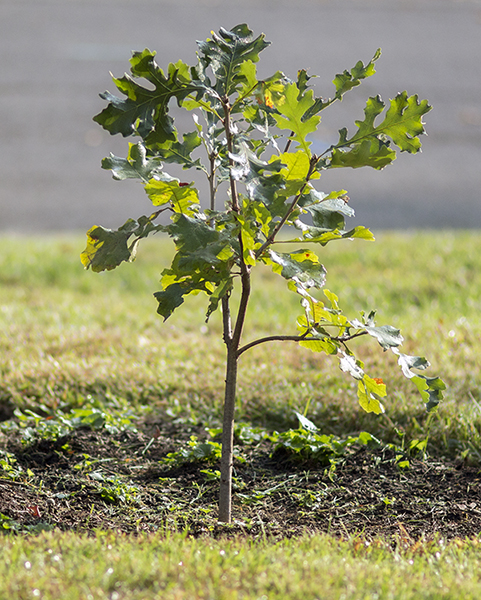
4. Plant multiple trees.
Instead of plopping a single specimen tree into your yard, consider planting a grouping of trees. “Trees truly are pack animals and they can communicate in a variety of ways,” explains Murray. “The same species of trees, two white oaks, can graft roots and they can share information. They can share water, they can share sugar.” Trees share resources and can communicate through symbiotic fungi (mycorrhizae) to tell other trees when they are under attack by, say, insects. Trees help each other to survive.
In a forest, clustered trees create a physical aerial buffer and also weave strong root systems that can better withstand the forces of nature. Multiple trees additionally provide each other’s bark with much needed shade.
5. Plant the right tree in the right location.
If you enjoy playing in the dirt, you’ve most likely heard the gardener’s mantra, “right plant, right place.” But I know of very few gardeners who faithfully adhere to that rule. What is it that makes us think we can force a plant to succumb to our will? Does adding an acid fertilizer or sand to the soil truly fix it? Is it sustainable to place a moisture-loving tree in a dry spot? To be certain, it would be simpler to choose a plant whose needs fit the conditions of the site.
“Right tree, right place, right function” is what Joe Murray promotes. With that edict in mind, here are some considerations:
• Understand that you’re planting a tree for the next few generations. Situating it where its root growth is restricted, growing it too close to a structure, or planting it under utility wires will likely force the next homeowner to remove it.
• Before deciding on a species of tree, learn its upper limits of height and width at maturity. What are its physical characteristics and its liabilities?
• Think about what role you want the tree to play in your landscape. Is its purpose to provide shade or privacy? Is it intended for erosion control or to help conserve energy? Do you want to support the greatest amount of wildlife?
• This is the big one: properly site your native tree to the conditions it would naturally grow in. Moisture, light, wind, topography, soil composition and pH should all be thoughtfully considered. Your regional Native Plant Society can guide you.
6. Ask “why prune a tree?”
Tree limbs have corresponding roots — so when a branch is removed, so dies its companion roots. This means excessive and incorrect pruning of live growth renders a tree vulnerable to drought, disease, insect infestation and more. Ask yourself not how and when to prune a tree but why.
Too often a tree is ‘limbed up’ for ease of mowing or simply because it’s a common practice. Trees with exposed bark are forced into a stressful situation. “It’s not natural for that bark and trunk to be hit with sunlight, that’s why [trees] put out water sprouts, to try and shade themselves and to put out future branching,” states Murray. “Keep the crown as low as possible; the same goes for branches.” Most of the thinning should be at the end of the branch, not at the trunk, to prevent sun scald and frost cracks. The trunk can continue to grow with its lower limbs attached — and ample leaves (and roots) help with photosynthesis.
Antiquated practices like cleaning out interior small branches (or water sprouts), lion tailing, thinning the canopy or topping will most likely catapult your tree to a premature death.
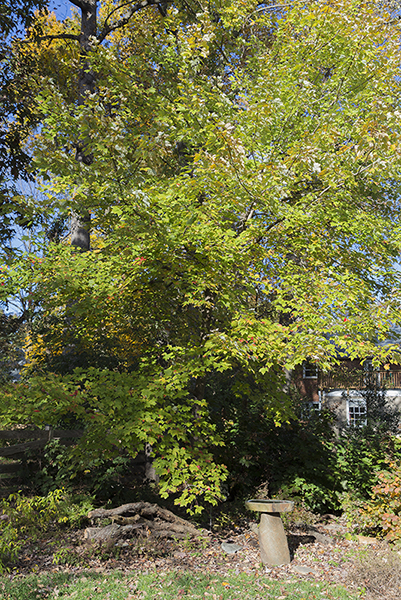
shade its trunk as well as the plants growing beneath it.
7. Beware of too much nitrogen.
“If you give a tree nitrogen and it doesn’t need it, you’re promoting the shoot system to grow rather than the root system. This results in a shoot system demanding more water than the root system can supply, resulting in a tree that’s more prone to experience drought stress.” Excess nitrogen also accelerates any decay-causing fungi already present in the tree and it openly invites insect pests.
Trees take up nitrogen when fertilizer is applied to turfgrass. “If you do something to the lawn, and you have tree roots growing underneath the lawn, are you doing something to the tree? Absolutely.”
Any manufacturers’ claims touting the use of a single nitrogen fertilizer for both lawns and trees should be highly scrutinized. Your tree may lack nutrients but unless you have your soil analyzed, you’re guessing. The priority is to test* your soil.
*A&L Eastern Laboratories soil test lab can also test for heavy metals.
8. Give trees what they want. (Hint: they don’t want lawn.)
“The bottom line is: imitate what is on the bottom of the forest floor.” Placing (not tilling in) two to four inches of wood chips over the roots of your trees and for gosh sake, leaving the leaf litter that comes from those trees, is an important step to encourage soil and tree health. Organic matter is fuel; it’s what keeps the root-fungi relationship healthy.
The ANSI standard now recognizes ‘mulch’ as arborist wood chips. “This is what I recommend, not only me, but it’s my entire industry that recommends this: wood chips.” Murray explains, “It’s not the same thing as the mulch you’re going to get from Lowe’s or Kmart or the box stores or nursery — it’s not shredded bark.”
Tree bark contains chemicals and anti-microbial fungi that are difficult for microorganisms to break down. It’s waxy so it repels moisture. It is not a good choice for mulch.

in a backyard forest setting.
Murray refers to a photo of a wood chipper in use. “It should be what’s coming out of that hopper right there. There’s going to be a lot of the meat of the tree and the branches; going to be a lot of that cellulose and the xylem that’s in the middle; there’s going to be some bark and there’s also going to be some small branches. There’s going to be some leaves, there’s going to be the forest floor … and that’s what we want.”
Murray illustrates his point by comparing photos of two young trees planted in research plots at Blue Ridge Community College in Virginia. One tree was surrounded by a 10-foot ring of wood chips; the other was left to duke it out with lawn. After a few growing seasons, the mulched tree was at least twice as large as the tree with its roots covered over in turfgrass. And it appeared to be exponentially healthier.
Murray’s wood chip advice also applies to mature trees growing in lousy disturbed soils and especially in lawn.
A note: Consider that some trees are chipped because they are diseased or invaded by invasive insects. If possible, ask about the condition of the tree before potentially spreading it as mulch in your landscape.
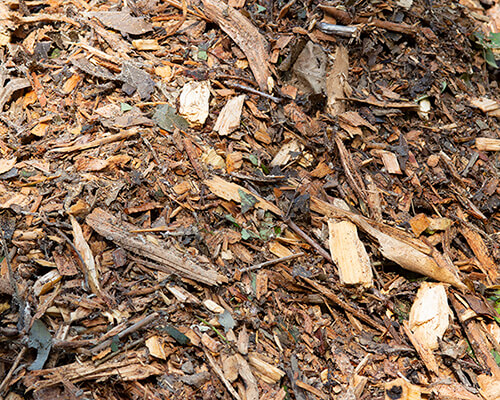
and will greatly benefit living trees.
Fine root density can be increased by as much as 400% by adding that two to four inches of the organic material out to the tree’s drip line. It’s easy to smother existing turfgrass. Murray again stressed, “If you can mimic what happens on the forest floor, then do it. That’s the right thing to do.”
Many tree removal companies provide chipped tree material at no cost. Contact some local businesses to see if they will deliver. You may be placed on a waiting list and be willing to accept a full truck load.
9. Volcano mulches are dumb.
The volcano mulch is a widespread phenomenon. Commercial landscapers as well as homeowners enthusiastically and regularly pile mulch high around the base of trees, leaving the shredded stuff to rest against the tree trunk. This causes the bark to fall off and the trunk to send out adventitious roots that can end up girdling the tree. Volcano mulching is a puzzling and detrimental practice that will shorten the life of a tree.
Mulch (or anything else) stacked up against a tree trunk also welcomes insect pests and small gnawing mammals, and encourages rot. Wood chips should be applied between two to four inches high, at least as wide as the tree canopy and it should never touch the trunk of a tree. For what to mulch with, see #8 above.
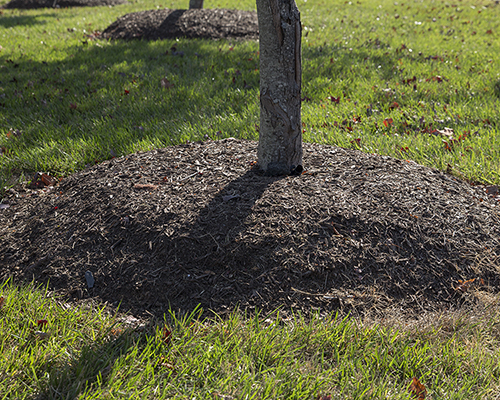
10. Say “no” to landscape fabric.
There are those who nonchalantly roll out landscape fabric over tree and shrub roots with hopes of suppressing weeds. But did you know that there are two sides to the fabric? One side will let moisture through but the other side doesn’t. Even if you do happen to lay it correct side up, those small pores will eventually clog, blocking life-sustaining water and oxygen to the soil and the plant’s roots. Landscape fabric prevents any organic material from working its way into the soil and it could also assist in girdling the tree. If you want to suppress weeds, see: “8. Trees want nature’s debris.”
11. Say “hell no” to herbicides.
Studies have shown that systemic non-selective herbicides (weed, brush and root killers) and selective broadleaf herbicides (found in Weed & Feed products) applied to foliage due to drift or to the soil or leaf litter in tree root zones can indirectly kill trees. At sub-lethal doses these herbicides can weaken a tree, predisposing it to cankers, borers and vascular diseases. Some tree species are more sensitive to these chemicals than others.
If you are contemplating using herbicides in your yard, realize your neighbor’s large tree probably has its roots growing on your property. I emphasize: roots extend three to five times beyond a tree’s drip line.
Resist applying herbicides not only because they harm trees and the environment but also because glyphosate (AKA Roundup) is designated “probably carcinogenic to humans” by the World Health Organization. Glyphosate as well as the broadleaf herbicide triclopyr and 2,4-D can contaminate groundwater and end up in your drinking water.

12. Too late to save it? Leave a dead tree standing.
A dead or dying tree, called a snag, is considered more important for wildlife than a living tree. The benefits of rotting wood are as numerous as the animals they sustain.
Woodpeckers occupy the cavities for nesting and shelter and live on the insects and other invertebrates that inhabit decaying snags. Other birds and creatures like squirrels, raccoons, owls, salamanders, frogs, snakes, foxes, bats, turtles, chipmunks and bears (to name just a few) also need snags and fallen trees for housing, cover, or food. Mushrooms and other fungi that magically appear on decomposing wood are a nutritious feast for animals.
Our overly sparse suburban landscapes can become better sanctuaries by allowing a dead tree to stand or lay. Any size trees or logs are valuable, but the larger they are, the more critters they will support.
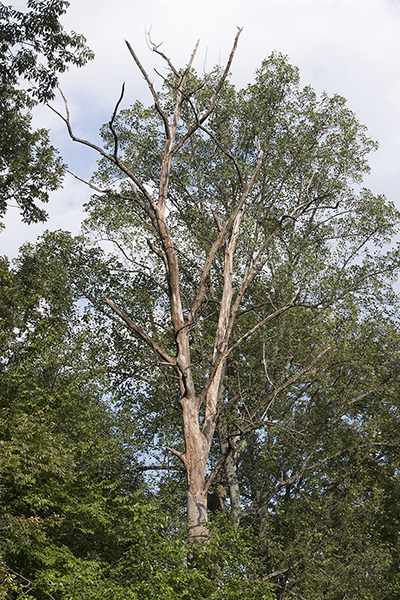
since we bought our house 10 years ago. Hang in
there and provide for another decade,
dear dead tree!
PREVENTION, PREVENTION, PREVENTION!
How did I contribute to the premature death of my own oak? Botanical malpractice, I confess. I have to look back a decade ago when Marc and I purchased our home. Knowing about as much, meaning as little, about trees as most people, I hired a company to remove the dead branches from our then vibrant tree and assumed that arborists would know what they were doing. But they unnecessarily cut living material as well as dead branches. I allowed a repeat offense a few years later. Excessive pruning was not the only detrimental mistreatment I inflicted. The oak was left struggling to grow in a sea of nutrient-sucking lawn while I recklessly fertilized the grass with a nitrogen-rich product. I did this on more than a few occasions. Adding further insults and injury, I stood by (semi) silently as a neighbor applied Roundup to kill his own weeds. He was also fond of the Weed & Feed.
When the oak’s decline became noticeable, I hired yet another arborist who worked for two years and deployed regular treatments of a systemic insecticide and a tree growth regulator, at a cost of thousands of dollars which, in the end, failed. I really can’t say if all the right things were done on his part or not. Had I been armed with the knowledge I have now, I would have been more proactive (or equally more hands off). Prevention is easy to prescribe but hard to achieve.
WHO DO YOU CALL?
Finding a savvy expert to assist you and your trees may be a challenge. Seek a licensed arborist, preferably a “certified consulting arborist,” who is active in organizations such as the International Society of Arboriculture and the Tree Care Industry Association. A consultant is not affiliated with a company that makes their money off of cutting down trees; you’ll pay them directly for their professional assessment. Ask questions. Do your own research. Do not make my mistakes. And may all your trees live full and productive lives.
Find a certified consulting arborist in West Virginia, Maryland, Washington DC and Virginia: https://goodtreecare.com/.
A huge thank you to Joseph Murray for his expertise. Murray holds a master of science in plant pathology from Virginia Tech, a master of teaching from the University of Richmond, and a bachelor of arts in biology from Radford University.
Updated January, 2023
